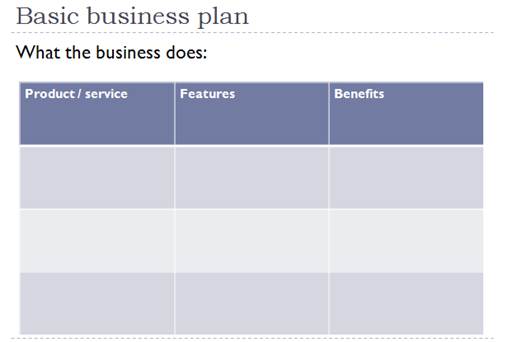What business plan do you need?
Zarzdzanie w MSP 5
A business plan has four main purposes:
} To help you to develop your vision of your business;
} To make sure you have thought of everything;
} To help you raise start-up finance;
} To compare your actual progress with what you planned at the outset.
What business plan do you need?
o Basic business plan;
o Full business plan:
o If you are looking for loans, grants or external investment.
Basic business plan:
} Business details
} Business goals
} What the business does
} What makes the business different
} Market research
} Profiling customers
} Profiling competitors
} Promotion and advertising
} Start-up costs
} Profit and loss forecast
} Cashflow forecast
Business details:
} Company name;
} Address;
} Telephone number(s);
} Email address;
} Legal status;
} Simple statement of what the business will do.
Business goals:
1. What do you want to achieve in your first year of business?
2. Where do you see your business in 3-5 years’ time?

Understand the features and benefits of your product / service:
} Features: attributes (atrybuty) of the product, such as its size, weight or design;
} Benefits: what the feature can do for the customer.
For example, a saucepan:
} Feature: non-stick coating on saucepan;
} Benefits:
} Food does not stick to the surface;
} Tastier food;
} Saves work.
What makes the business different:
} Your product/service is unique or different compared with the competition because:
Market research:
} Trends in your chosen market are:
} How you know this:
Profiling customers:
} The customer groups you will be selling to are:
} Your customer research has shown what your customers want is:
} How you know this:
} Number of customers you expect to win in each group and what they might pay:


Promotion and advertising:
} How and where will you promote your product/service?
Start-up costs:
} IT and computers
} Telephones and broadband equipment
} Stock
} Tools
} Vehicles
} Professional fees
} Insurance
} Rent/rent deposit
} Stationery
} Marketing
} Consumables
} Licences
} Training
} Association fees
} Wages/recruitment
} Security/health and safety equipment
} Market research costs
} Other: (please specify)

Starting from your expected sales, work out your variable costs:
} Goods;
} Materials;
} Extra labour;
} Transport.
Calculate your fixed costs:
o Premises (rent, service charges);
o Utilities;
o Telephone and broadband;
o Salaries;
o Printing, post and stationery;
o Advertising and promotion;
o Bank charges and interest;
o Insurance;
o Equipment and vehicle leasing.


What business plan do you need?
o Basic business plan;
o Full business plan:
o If you are looking for loans, grants or external investment.
Full business plan
Contents:
} Executive summary
} 6.1 Executive summary
} 6.2 Business details
} 6.3 Key personnel
} Vision
} 6.4 The business idea
} 6.5 Business goals
} 6.6 What the business does
} 6.7 What makes the business different
} 6.8 Legal requirements
} Marketing
} 6.9 Market research
} 6.10 Profiling customers
} 6.11 Profiling competitors
} 6.12 Managing market risks
} 6.13 Pricing
} 6.14 Promotion and advertising
} Running the business
} 6.15 Staff
} 6.16 Premises
} 6.17 Suppliers
} 6.18 Equipment
} 6.19 Managing operational risks
} Finances
} 6.20 Start-up costs
} 6.21 Profit and loss forecast
} 6.22 Sourcing finance
} 6.23 Managing financial risks
} 6.24 Cashflow forecast
The business idea:
} Sum up your business idea:
Legal requirements:
} The legal and insurance requirements that apply in your business are:
} You will meet your legal and insurance requirements by:
Managing market risks:
} Write down the risks you have identified:
} How you will manage these risks so that they become less of a threat:







Managing financial risks:
} The risks that you’ve identified for your financial forecasts are:
} How you will minimise their impact: